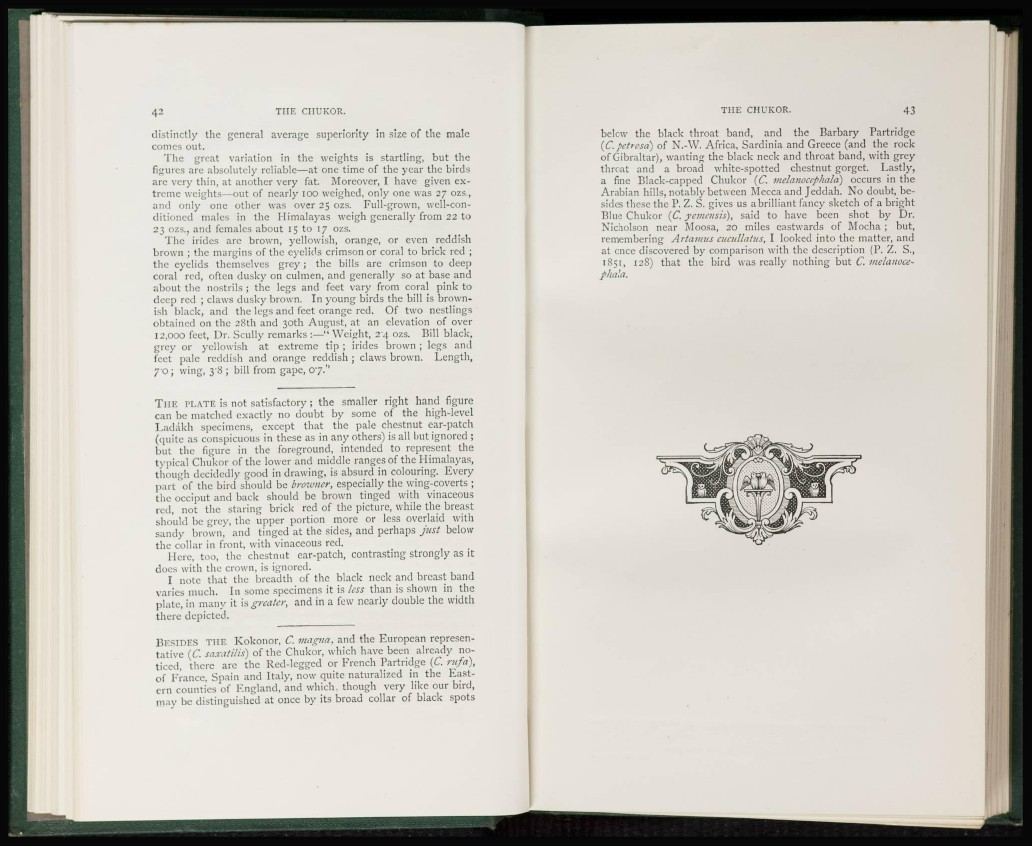
distinctly the general average superiority in size of the male
comes out.
The great variation in the weights is startling, but the
figures are absolutely reliable—at one time of the year the birds
are very thin, at another very fat. Moreover, I have given extreme
weights—out of nearly 100 weighed, only one was 27 ozs.,
and only one other was over 25 ozs. Full-grown, well-conditioned
males in the Himalayas weigh generally from 22 to
23 ozs., and females about 15 to 17 ozs.
The irides are brown, yellowish, orange, or even reddish
brown ; the margins of the eyelids crimson or coral to brick red ;
the eyelids themselves grey; the bills are crimson to deep
coral red, often dusky on culmen, and generally so at base and
about the nostrils ; the legs and feet vary from coral pink to
deep red ; claws dusky brown. In young birds the bill is brownish
black, and the legs and feet orange red. Of two nestlings
obtained on the 28th and 30th August, at an elevation of over
12,000 feet, Dr. Scully remarks :—"Weight, 24 ozs. Bill black,
grey or yellowish at extreme tip ; irides brown ; legs and
feet pale reddish and orange reddish ; claws brown. Length,
7 0 ; wing, 38 ; bill from gape, 07.''
T H E PLATE is not satisfactory ; the smaller right hand figure
can be matched exactly no doubt by some of the high-level
Ladakh specimens, except that the pale chestnut ear-patch
(quite as conspicuous in these as in any others) is all but ignored ;
but the figure in the foreground, intended to represent the
typical Chukor of the lower and middle ranges of the Himalayas,
though decidedly good in drawing, is absurd in colouring. Every
part of the bird should be browner, especially the wing-coverts ;
the occiput and back should be brown tinged with vinaceous
red, not the staring brick red of the picture, while the breast
should be grey, the upper portion more or less overlaid with
sandy brown, and tinged at the sides, and perhaps just below
the collar in front, with vinaceous red.
Here, too, the chestnut ear-patch, contrasting strongly as it
docs with the crown, is ignored.
I note that the breadth of the black neck and breast band
varies much. In some specimens it is less than is shown in the
plate, in many it is greater, and in a few nearly double the width
there depicted.
BESIDES THE Kokonor, C. magna, and the European representative
[C. saxatilis) of the Chukor, which have been already noticed,
there are the Red-legged or French Partridge (C. rufa),
of France, Spain and Italy, now quite naturalized in the Eastern
counties of England, and which, though very like our bird,
may be distinguished at once by its broad collar of black spots
below the black throat band, and the Barbary Partridge
(C. petresa) of N.-W. Africa, Sardinia and Greece (and the rock
of Gibraltar), wanting the black neck and throat band, with grey
throat and a broad white-spotted chestnut gorget. Lastly,
a fine Black-capped Chukor {C. melanoccpliala) occurs in the
Arabian hills, notably between Mecca and Jcddah. No doubt, besides
these the P. Z. S. gives us a brilliant fancy sketch of a bright
Blue Chukor {C. yemensis), said to have been shot by Dr.
Nicholson near Moosa, 20 miles eastwards of Mocha ; but,
remembering Artamus cueuILitns, I looked into the matter, and
at once discovered by comparison with the description (P. Z. S.,
185r, 128) that the bird was really nothing but C. melanocep/
iala.